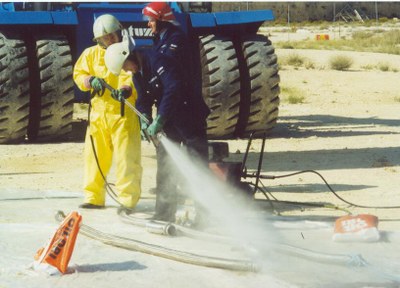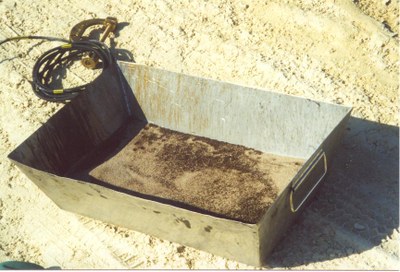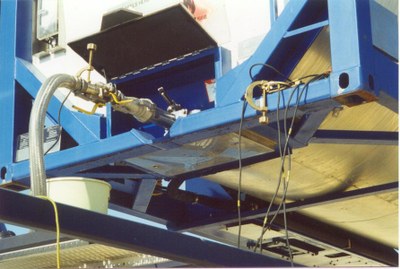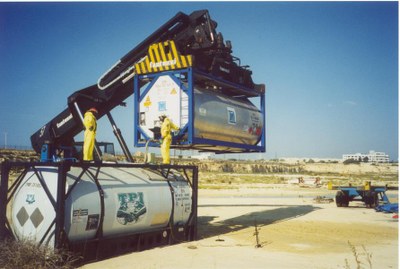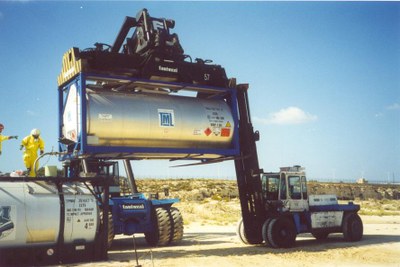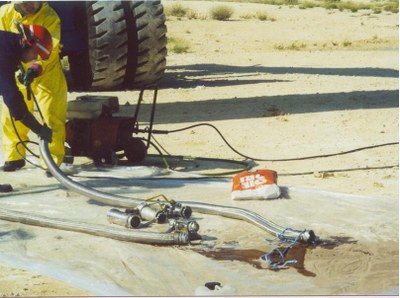2000 - Heildelberg Express
| Year | 2000 |
| Vessel | Heildelberg Express |
| Location | Marsaxlokk Port, Malta |
| Cargo type | Package |
| Chemicals | ACRYLIC ACID inhibited |
Summary
An ISO tank container loaded with acrylic acid (inhibited) was found leaking on the vessel "Heidelberg Express" on route to Saudi Arabia. The container was offloaded at the Freeport Harbour, Marsaxlokk, Malta on 12 October 2000 and placed in an isolated area. The leak from the tank container was estimated to be about 0.001 litre/minute.
Acrylic acid is a colourless, watery liquid with an irritating, acrid smell. It is toxic by ingestion, flammable, corrosive, carcinogenic and will burn skin on contact. It is the first derivative of propylene but can be produced by a number of other processes. It is manufactured in a number of grades according to its end use, the most widespread of which are technical (94 per cent pure) and glacial, or GE (over 98 per cent pure). Glacial grades are used in the manufacture of acrylic acid esters. Acrylic acid has a range of applications in coatings, paints and in the manufacturing of textiles, in cement and paper processing sectors and as a source of acrylic polymers, i.e. polyacrylic acid, polymetacrylic acid and other acrylic polymers.
Acrylic acid is a monomer having a specific gravity slightly higher than water and is water-soluble. It has a boiling point of about 141°C depending on its grade, a melting point of about 12ºC and a low flash point of 54°C. It will polymerize spontaneously at elevated temperatures when in contact with a number of impurities and this property has a significant effect on cargo handling requirements during normal shipping and handling of the product during emergencies. Acrylic acid is a Pollution Category D substance according to Annex II of MARPOL 73/78, i.e. it poses a low pollution risk and designated Class 8 (corrosive) with a subsidiary flammable liquid hazard under the IMDG Code.
Being a monomer and hence an unstable material, acrylic acid must be stabilized before shipment through the use of an inhibitor to prevent unexpected and violent polymerization during transport. The grade of the acrylic acid determines the amount of inhibitor needed. High-purity glacial grade is seldom transported in bulk since it is difficult to inhibit polymerization while at the same time maintaining the purity level. For technical grade product phenotiazine at 500ppm is added to shipments although other inhibitors such as hydroquinone or a mixture of hydroquinone and phenotiazine up to concentrations of 1000ppm are used as the inhibitor. Importantly, to note that although acrylic acid is completely water soluble, the presence of the inhibitor decreases its solubility.
Narrative
An ISO tank container loaded with acrylic acid (inhibited) was found leaking on the vessel "Heidelberg Express" on route to Saudi Arabia. The container was offloaded at the Freeport Harbour, Marsaxlokk, Malta on 12 October 2000 and placed in an isolated area. The leak from the tank container was estimated to be about 0.001 litre/minute.
Acrylic acid is a colourless, watery liquid with an irritating, acrid smell. It is toxic by ingestion, flammable, corrosive, carcinogenic and will burn skin on contact. It is the first derivative of propylene but can be produced by a number of other processes. It is manufactured in a number of grades according to its end use, the most widespread of which are technical (94 per cent pure) and glacial, or GE (over 98 per cent pure). Glacial grades are used in the manufacture of acrylic acid esters. Acrylic acid has a range of applications in coatings, paints and in the manufacturing of textiles, in cement and paper processing sectors and as a source of acrylic polymers, i.e. polyacrylic acid, polymetacrylic acid and other acrylic polymers.
Acrylic acid is a monomer having a specific gravity slightly higher than water and is water-soluble. It has a boiling point of about 141°C depending on its grade, a melting point of about 12ºC and a low flash point of 54°C. It will polymerize spontaneously at elevated temperatures when in contact with a number of impurities and this property has a significant effect on cargo handling requirements during normal shipping and handling of the product during emergencies. Acrylic acid is a Pollution Category D substance according to Annex II of MARPOL 73/78, i.e. it poses a low pollution risk and designated Class 8 (corrosive) with a subsidiary flammable liquid hazard under the IMDG Code.
Being a monomer and hence an unstable material, acrylic acid must be stabilized before shipment through the use of an inhibitor to prevent unexpected and violent polymerization during transport. The grade of the acrylic acid determines the amount of inhibitor needed. High-purity glacial grade is seldom transported in bulk since it is difficult to inhibit polymerization while at the same time maintaining the purity level. For technical grade product phenotiazine at 500ppm is added to shipments although other inhibitors such as hydroquinone or a mixture of hydroquinone and phenotiazine up to concentrations of 1000ppm are used as the inhibitor. Importantly, to note that although acrylic acid is completely water soluble, the presence of the inhibitor decreases its solubility.
Resume
An initial survey took place by representatives of the vessel and cargo owners of the company which leased the container, authorities which certified the construction of the tank container and the port authorities. It was decided that since the leak could not be plugged, a tank-to-tank transfer would need to be carried out. BASF in Ludwigshafen, Germany, manufacturers of the product, were contracted by the owners of the product to handle this operation. For this purpose, three officers from the BASF Fire Department, together with transferring equipment, were sent over to Malta. One of the officers arrived on 19 October, a few days earlier, to survey the situation and to liaise with the BASF Fire Department to ensure the appropriate equipment was sent for the tank-to-tank transfer. The rest of the members of the team with equipment arrived on 20 October.
The chemical industry in Europe (CEFIC) operates a network of focal points and schemes of mutual assistance between companies that can be called upon by the emergency authorities for expert advice and assistance in chemical transport accidents. This is known as ICE Emergency Response Programme. Both REMPEC and BASF participate in this programme and REMPEC, being situated in Malta, was asked to assist BASF personnel in the logistic arrangements and to facilitate contact between the various authorities to ensure easy access to the site and to facilitate custom clearance for entry and exit of equipment.
Arrangements by representatives of the cargo were also made for a replacement tank container to be sent to Malta by the company contracted for transporting the product. This arrived in Malta from Italy on 21 October.
The transfer operation was carried out on Monday 23 October. A reach stacker was used to lift the leaking container. The product was decanted from the leaking tank container into the alternate container by gravity loading through the manhole open to the atmosphere. The cargo flowed under gravity (Figure 1) through a steel hose which was connected to the bottom valve of the leaking container and extended to the bottom of the replacement tank container below. This avoided slashing whilst the velocity of the liquid entering the tank was also controlled which avoided excessive turbulence. Splashing and turbulence can create a potentially flammable mist which can ignite where build up of a static electricity is possible. To minimize the dangers arising from the accumulation of electrostatic charge, the tank containers were earthed by means of an electrical connection between the steel tank containers and the ground (Figure 2). Generally, when carrying out an operation of this kind, it is recommended that earthing takes place where the product's flash point is less than 60°C. Drip-trays containing aluminium silicate were also placed under the leaking container to collect any acrylic acid leaks (Figure 3). When most of the acrylic acid was transferred, the remaining liquid was transferred by slightly titling the raised container with a forklift (Figure 4).
Following transfer, hoses and other equipment were decontaminated by washing with water. A simple decontamination area was set up using plastic sheets (Figure 5). Residual acrylic acid remaining in the hoses was poured over aluminium silicate and the hoses and other equipment washed with a fine water spray (Figure 6). Since acrylic acid is a "ready biodegradable" substance, all wastes from the decontamination process were sent to a landfill. The transfer operation took approximately 3 hours. Since the origin of the leak was not determined, the damaged tank container was allowed to drip for an additional 24 hours after which it was shipped on 31 October to the Port of Rotterdam where the leasing company of the tank container had a facility. The requirements followed for the transportation of the empty damaged container was that as stipulated by the IMDG Code, namely that an unclean container should be treated as a loaded container with product. The full container left for Saudi Arabia on 29 October.
It is also recommended that for acrylic acid carried in bulk, if the temperature of the cargo whilst at sea increases by more than 4°C per hour for no obvious reason, then extreme caution must be observed. Should the temperature of the acrylic acid bulk cargo reach the high alarm level of 32°C, then the temperature should be checked every 30 minutes, the temperature plotted and shore staff informed. If the temperature reaches 38°C, then the crew should prepare cargo-jettisoning equipment and tank cleaning hatches opened to release cargo pressure. If the cargo reaches 41°C, it is highly recommended that it is jettisoned. Once 25 per cent has been jettisoned, the remaining cargo can be cooled by introducing cold freshwater into the tank bottom.
Jettisoning the acrylic acid and adding cold water should be continued until the tank is emptied of cargo. Freshwater should be used rather than seawater as seawater does not dissolve the polymer and hence, makes pumping more difficult.
Although such action is inadvisable from a commercial standpoint, polymerization is highly dangerous for the safety of the ship at sea.


